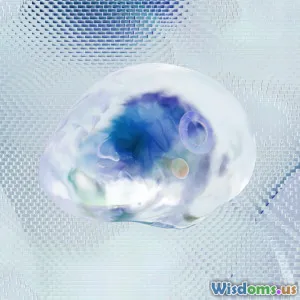
Comparing Open Versus Closed Library Floor Plans for All Ages
16 min read Discover how open and closed library floor plans impact users of all ages, examining their advantages, drawbacks, and best-fit solutions for modern communities. (0 Reviews)
Comparing Open Versus Closed Library Floor Plans for All Ages
Libraries are not mere warehouses of books—they are vibrant community hubs, learning sanctuaries, and spaces of quiet contemplation or lively connection. In designing these dynamic environments, the debate between open versus closed floor plans is hotter than ever. Which foster creativity, inclusivity, and learning for patrons of all ages? How do these choices impact atmosphere, services, and long-term adaptability? In this deep dive, we dissect the crucial contest between open and closed library floor plans, exploring the benefits, limitations, and nuanced needs of multi-generational users. Prepare to see your local library through new eyes.
Table of Contents
- Introduction: Libraries Beyond the Books
- Defining Open and Closed Library Floor Plans
- Open Floor Plans: A Vision of Flexibility
- Advantages for All Ages
- Real-World Example: DOK Library, Netherlands
- Challenges and Considerations
- Closed Floor Plans: Cultivating Focus and Security
- Benefits Across Demographics
- Real-World Example: New York Public Library, Stephen A. Schwarzman Building
- Challenges and Considerations
- Comparing Through the Lens of All Ages
- Children
- Teens and Young Adults
- Adults and Seniors
- Staff and Operations
- Blended & Adaptive Approaches: The Hybrid Library
- Strategies in Practice
- Community-Driven Design
- Conclusion: Designing Libraries that Grow with Us
Introduction: Libraries Beyond the Books
In the age of e-books, streaming media, and online learning, the physical library might appear to be fighting for relevance. However, library visits in the United States grew in the decade before the pandemic, with The Institute of Museum and Library Services reporting over 1.17 billion visits in 2017 alone. So, if people can access knowledge digitally, why do they keep coming?
The answer lies in what a library represents—a shared communal space for curiosity, growth, and a sense of belonging. Yet, as libraries adapt to shifting community needs, questions linger on how their layouts support (or inhibit) inclusivity, quiet, safety, and creativity. Should they tear down walls for a flexible, light-filled, open-plan experience—or segment activities thoughtfully, prioritizing privacy, security, or acoustic control with a closed-plan design?
The debate centers not purely on aesthetics, but on the end experience: how patrons—from toddlers to teens to seniors—feel, connect, and thrive within those walls.
Defining Open and Closed Library Floor Plans
Before venturing into their impacts, let's define the two major architectural approaches:
Open Library Floor Plan:
- Features minimal internal walls
- Spaces are visually and physically accessible to everyone
- Collections, services, and seating areas flow together with few barriers
Closed Library Floor Plan:
- Spaces divided by walls, partitions, or enclosed rooms
- Distinct areas for activities such as reading, group study, children's programs, and meetings
- Increased ability to manage light, sound, and visibility
It’s important to note there is rarely a binary choice; these models often represent ends of a spectrum. The best libraries may skillfully combine elements of both philosophies.
Open Floor Plans: A Vision of Flexibility
Advantages for All Ages
Open library layouts have surged in popularity since the late 20th century, in step with architectural trends favoring transparency, flexibility, and communal interaction. Here’s why:
1. Enhanced Visibility and Navigation
- Visitors can orient themselves quickly; sight lines enable easy browsing and wayfinding.
- Staff can monitor all areas, improving child safety and reducing the risk of theft or inappropriate behavior.
2. Flexibility for Programs and Changing Needs
- Movable furniture and collections adapt for workshops, pop-up events, or new user trends.
- During the COVID-19 pandemic, open plans allowed libraries to quickly reconfigure layouts for distancing, outdoor access, and ventilation.
3. Promoting Community and Collaboration
- Open layouts encourage casual interaction: parents can supervise children while working, teens may form study groups, seniors engage in group activities.
4. Abundance of Natural Light
- Fewer interior walls maximize daylight, reducing energy costs and creating an uplifting atmosphere—a boon for well-being, as natural lighting is linked to improved mood and cognitive functioning.
Real-World Example: DOK Library, Netherlands
Widely regarded as one of the world’s most innovative libraries, the DOK Library Concept Center in Delft, Netherlands, demonstrates the power of an open plan:
"A community's living room, open and inviting. Users create their own journeys through the collections, kids wander freely, and there’s always something new around the corner."—Erik Boekesteijn, Project Manager, DOK Library
At DOK, spaces melt seamlessly into one another. There are areas for graphic novels, music, art exhibitions, and even a sound studio, curated without traditional boundaries yet organized via clever signage and furniture.
Challenges and Considerations
- Noise Levels: Open spaces can magnify sound, sometimes at odds with patrons seeking quiet, focused reading or study.
- Lack of Privacy: Teens, adults, or anyone needing solitude may feel exposed; confidential conversations (tutoring, counseling, etc.) are harder to accommodate.
- Security Concerns: Open plans may make it easier for items to leave undetected unless staff are especially vigilant or security tools (RFID gates, cameras) are well deployed.
- Inclusive Design Dilemmas: People with sensory sensitivities or autism may feel overwhelmed without smaller, enclosed spaces or clear boundaries.
Closed Floor Plans: Cultivating Focus and Security
Benefits Across Demographics
Closed floor plans—with more enclosed rooms or walled sections—hark back to the traditional library model, but their value endures, especially when:
1. Prioritizing Quiet and Concentration
- Reading rooms or small study pods can be soundproofed, supporting deep work and reflection for any age group.
2. Designing for Specific Programs or Age Groups
- Children's rooms allow vocal story times without disrupting adult patrons.
- Teen centers give autonomy and privacy for group work, away from younger kids or supervising eyes.
- Meeting rooms can host classes, book clubs, and even telemedicine or social work consults.
3. Enhanced Security and Control
- Restricted access blocks; this is valuable for preserving rare books, tech hubs, or after-hours programs without opening the full library.
- Clear boundaries create a sense of ownership and calm, benefiting users with behavioral or sensory differences.
Real-World Example: New York Public Library, Stephen A. Schwarzman Building
The iconic NYPL Main Branch exemplifies closed-plan capacity at scale: ornate reading rooms, specialized reference areas, and dedicated children’s rooms all separated by walls or grand doors.
During its 2019 renovation, NYPL’s Rose Main Reading Room—the largest of its kind—was restored as a sanctuary for concentrated research, walling off interior distractions while still accommodating over 636 users under a single (vast) ceiling.
Challenges and Considerations
- Reduced Flexibility: Major renovations to adapt rooms can be costly or disruptive.
- Wayfinding Hurdles: With more rooms come more complex navigation, challenging for newcomers, particularly children or seniors unfamiliar with the space.
- Barriers to Inclusivity: Users feel separated—teens may not see community events; parents may struggle to use adult resources while supervising kids; spontaneous programming is harder to coordinate.
Comparing Through the Lens of All Ages
How do these layouts truly impact patrons at different life stages? Let’s break it down.
Children
Open floor plans spark curiosity—the sight of books, play areas, and peers creates a world to freely explore. However, young children need safety. The American Library Association (ALA) recommends clear sightlines and proximity to circulation desks. A closed children’s room secures boundaries (“runaway” prevention), keeps noise contained during story hours, and enables specialized furnishing (soft seating, manipulatives).
Many modern libraries use partial glass partitions or themed, semi-enclosed spaces to grant both visibility and boundary.
Example: Seattle Public Library’s children’s area clusters defined zones with playful arches—open to adults yet gated for child safety, blending both paradigms.
Teens and Young Adults
Teens crave both autonomy and community. Open areas invite browsing and socialization, but adolescent privacy needs are acute; being overlooked en masse isn’t ideal. Many libraries have pivoted to “Teen Zones”—rooms or corner enclaves separated (but visible) from adults and kids, with gaming, tech tools, and cozy nooks built in.
Closed plan elements (sensory rooms, AV labs, homework pods) foster trust and ownership among this group—a recipe for engagement and reduced hesitation in using library resources.
Adults and Seniors
Adults and seniors range from students needing collaborative space to older folks seeking silent reflection, computer use, or health workshops. For book clubs and classes, controlled, enclosed rooms make programming possible through schedule flexibility and minimized distraction.
Surveys by the UK’s Chartered Institute of Library and Information Professionals (CILIP) show adults rank quiet and resource accessibility as their top priorities—a design challenge for endless openness.
For seniors with mobility or cognitive needs, an intuitive, gentle layout is vital. Closed plans can compartmentalize resources too much; navigable open spaces, marked by clear signs and gentle color cues, create a welcoming experience.
Staff and Operations
A well-positioned open plan maximizes lines of sight—staff can serve, supervise, and connect with more patrons instantly, which is especially advantageous when labor resources are tight. Yet, staff also need offices, storage, and protected work zones.
Many libraries now implement “open service desks” in central locations with adjacent, staff-only back offices that provide necessary seclusion for confidential work and breaks, balancing both philosophies.
Blended & Adaptive Approaches: The Hybrid Library
Library science increasingly favors hybrid models. Harvard’s Graduate School of Design calls this trend “designing for resilience”—fusing open and closed concepts so libraries can adapt to user needs, pandemics, evolving media, and the relentless pace of change.
Strategies in Practice
- Zoning by Activity, Not Just Demographic: Open reading areas flow into semi-closed study rooms and event halls.
- Moveable Walls and Modular Furniture: Allows transformation from silent study to story time in minutes.
- Glass Enclosures: Confer a visual sense of openness while providing remarkable acoustic buffering—often crucial in bustling city branches.
- Dedicated Rooms-within-Rooms: Peer into Austin Central Library’s "Shared Learning Rooms,” or the adaptable pods at Toronto’s Albion Library.
Community-Driven Design
Libraries increasingly involve the community in planning, through surveys, participatory design sessions, and usability testing. This leads to:
- Cultural Customization: Multilingual signage or spaces for community traditions in neighborhoods with high immigrant populations
- Age-Specific Zones with Overlaps: For example, a parenting collection next to the children’s room, so caregivers can find resources while children play within line of sight
- Sensory Rooms: Closed, dimmable, sound-controlled havens for autistic, neurodiverse, or anxious users—often born from direct patron feedback
Example: The Columbus Metropolitan Library (Ohio) went through an extensive community redesign, resulting in a network of branches with vibrant, light-filled open reading rooms, interspersed with glass-walled study nooks, dedicated children's worlds, and tech labs—each benefiting all ages.
Conclusion: Designing Libraries that Grow with Us
Choosing between open and closed library floor plans isn’t just a matter of design—it’s a commitment to how we wish our community to feel, interact, learn, and belong. Libraries that thrive welcome difference: they embrace joyful noise and reflective solitude; play and serious scholarship; familiar comfort and flexible possibility.
No single plan prevails for all ages or all purposes. The libraries of the future are collaborative hybrids—responsive spaces shaped by, and with, their communities. They are testaments that, in every generation, the library is more than a room with books—it’s a living blueprint for inclusive, resilient public life.
If you’re a library lover, architect, or community advocate: Visit your local branch. Ask how its space shapes your experience—and imagine together how it could grow for all ages.
Rate the Post
User Reviews
Other posts in Interior Design
Popular Posts














